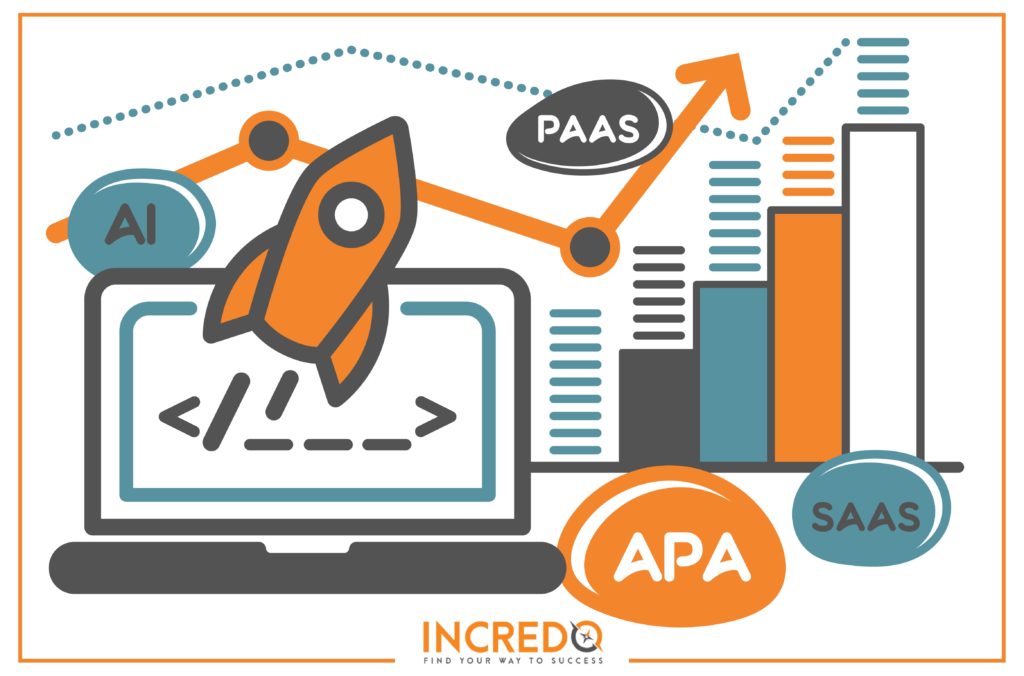Enterprise SaaS Spending Statistics and Trends for 2021

Enterprise SaaS Spending Statistics and Trends for 2021
SaaS has been growing at rapid rates during the past several years. The competition is already huge and it’s only increasing. In 2018, SaaS companies reported having over 9 competitors on average, which makes companies invest even more money into paid channels to get more leads. In this blog post, we’ll reveal the main SaaS spending and trends that you should follow.
SaaS Spending’s Data and SaaS Adoption Forecast
We live in an era of simplicity, intelligence, and data. SaaS is the combination of these three attributes. Businesses want to achieve high efficiency in the shortest time, in order to stay competitive and relevant. The SaaS world makes this possible with smart solutions. The growth of SaaS was especially dramatic in 2018 as it became a year of breakthrough for many SaaS companies. Most companies invested in project management and task management apps, as well as file sharing and backup software.
The enterprise SaaS is a mature market, however, SaaS accounts for less than 15% of total enterprise SaaS spending. But the market is big. And the forecast is that all SaaS segments will grow substantially all over the world in the coming years. Smart businesses are increasing their IT budgets to replace current outdated infrastructure and support the digital transformation initiatives. Adopting cloud-based infrastructure will allow larger companies to drop their expenditure of the total operating costs. In 2019, software and cloud budgets will remain steady at 26% and 21% respectively, in terms of IT budget allocation. Budget is allocated between the following SaaS sectors: operating systems (12%), virtualization (10%), productivity (10%), and security software (10%). Enterprises with over 5,000 employees will allocate the biggest part of their software budget to productivity solutions. Mid-size companies will prioritize virtualization software. Small organizations will invest mostly in operating systems.
You need to closely monitor how software is used by businesses to understand what’s loved most and thus spot some trends that are on the rise. Studying the data of SaaS expenditure will help your business make better decisions regarding your own money and reveal new opportunities. One major achievement of the SaaS world in 2018 was that the SaaS spending gap in the software vs hardware battle increased, as companies started spending more on SaaS than hardware. In the rest of the post, we’ll reveal the top 5 trends of the SaaS industry for the year of 2019.
Top 5 Trends of SaaS in 2021

Customer Success with Artificial Intelligence
Artificial Intelligence (AI) is taking SaaS on a completely new level. AI-optimized SaaS solutions are a big trend in 2021. The technological revolution would’ve not been so epic without AI. The algorithms AI uses aim to create intelligent machines that would work and act similar to humans, thus increasing the productivity and efficiency of businesses. SaaS and AI capabilities will create new ways to improve security, supplement human capacity, and get more value from data/automation.
Machine Learning, which is a big part of AI, will enable companies to improve customer service by offering AI-powered chatbots and other similar automation processes. AI-optimized SaaS solutions will also improve customer service by offering personalization via NLP, which is a technology that automatically processes speech patterns and voice control in different languages.
The Rise of PaaS and Micro-SaaS
With the rising competition, SaaS companies constantly try to find new ways to differentiate themselves and offer superior services. In 2021, more companies were expected to adopt PaaS (Platform as a service) to improve their value proposition and acquire a bigger market share. PaaS solutions offer 3 main advantages:
- The ability to build custom apps as add-ons to the original services, enhanced functionality and features, along with creative and innovative approaches.
- High level of security due to the fact that PaaS developments perform a host of automatic updates regularly.
- PaaS offers a more flexible way to scale your business, as it’s easy to use and accessible.
As for the micro-SaaS solutions, these are yet another way to win a competitive edge. In 2021, the trend is to find a new and innovative way to create value to the clients. In a nutshell, micro-SaaS targets a niche market and has a narrow focus towards fixing a specific problem within an existing larger product. Micro-SaaS offerings are usually operated by a small team or just one or two people and aim to enhance an existing SaaS product. It’s a small detail that complements a missing feature. These will be extremely valuable in 2021.
API Connectors
API or an Application Programming Interface is an essential part of the SaaS development process. Companies that adopt software usually need a solution for integrating it into their existing business system. However, the integration part has been quite a burden of SaaS companies for many years. With the growing adoption of SaaS solutions by enterprises, the urge to create a simple yet effective integration mechanism has emerged.
SaaS companies usually preferred to outsource the supply of APIs that enable cloud integration into their current system to third-party companies. They were unable to come up with a complete integration solution, so outsourcing was the only viable way to keep customers happy and satisfied. In 2021, one of the SaaS trends is to come up with an API connection way to satisfy their customers with in-house solutions. Having more experience, the cloud vendor’s services will provide integration solutions and capabilities to their clients to meet all their requirements.
Decentralization of SaaS and App-Person Connections
SaaS used to be centralized by the IT management, but today, with thousands of SaaS apps and solutions available, it’s simply impossible for IT to evaluate and choose the right software solution for each department. The amount of SaaS apps and their ease of use has made them decentralized over the departments of the company. In 2019, companies will push their departments towards individual SaaS implementation and usage, in order to be even more effective.
It’s important to note that a decentralized approach can end up in chaos. So companies should have a specific SaaS purchase strategy, in order to avoid any confusions. For example, there can be a scenario when two departments buy the same software. And this ends up in a double purchase. There can be another situation when a person who bought software has left the company. And the subscription was left with no billing owner. Such issues can be a serious problem for companies with over 100 employees. That’s why in 2021, enterprises will create a SaaS purchase strategy to map out app-person connections for managing, tracking and securing all the purchases.
Start-ups and SaaS Solutions
Start-up companies spend almost all of their first-year revenue on customer acquisition. However, this is not the most effective strategy for any company, either new or old. Smart business owners know that it’s much more efficient to satisfy your current clients than acquire new ones. Acquiring a new customer is five times more expensive than retaining an existing one, while retention is the base for having loyal and happy customers. It’s important that start-ups understand the basics of customer success and recognize that it’s the backbone of their company. The competitive world of business doesn’t have mercy for anyone. You either win or lose and there’s no in between.
How To Effectively Undertake New SaaS Development Projects

A big question for many Enterprise SaaS Development companies is whether to outsource to an agency or hire in-house specialists to undertake new development projects. Outsourcing is a great solution for businesses on tight budgets and resources. If executed correctly, it can be very fast and effective for larger projects and companies that are overloaded with current work and can’t invest more time and money into hiring an in-house team. Outsourcing the SaaS development to an agency is cost-efficient and takes a lot of hassle out of traditional in-house hiring. However, if you plan on having a long-term project, hiring an in-house team would be a better decision. The in-house approach is relatively pricier and requires more efforts to maintain. But it’s definitely worth the effort in the long-run.
The SaaS market is ripe with opportunities. And the only way to succeed is to come out with a fresh and unique solution. So regardless you undertake the project in-house or outsource it to an agency, remember that in order to make strategic decisions, the process of SaaS development must be backed by a sound policy framework and a definitive objective. Check out this SaaS Enterprise Development Guide which will help you kickstart your software business.
The SaaS world is undergoing an epic growth at rapid rates and there are no signs of slowing down. The only way to win this game is to have a forward-thinking approach. Keep up with the SaaS trends of 2021 to drive your SaaS business objectives towards successful outcomes.
Tags:
SaaS Growth
November 20, 2020

![Your SaaS Business Social Media Marketing Complete Guide [2021]](https://incredo.co/hs-fs/hubfs/Imported_Blog_Media/phone-1.jpg?width=520&height=294&name=phone-1.jpg)

Comments